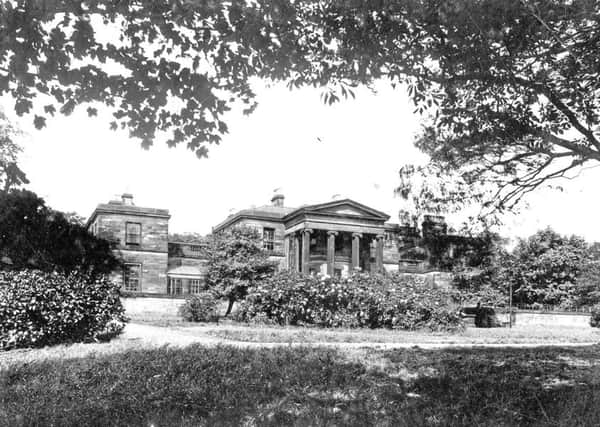Benjamin Gott: Captain of industry


Born in 1762 at Woodall, near Calverley, several miles west of Leeds, Benjamin Gott was the son of John Gott, a civil engineer. Gott senior knew canal engineer James Brindley and was involved with the management of the Aire and Calder Navigation.
Benjamin Gott attended Bingley Grammar School until he was 17. During 1780 his father apprenticed him to an old-established firm of Wormald and Fountaine, Leeds cloth merchants, for a fee of £400. The firm’s home trade in 1782 was estimated at £30,000 per annum, and the foreign at £10,000.
Advertisement
Hide AdAdvertisement
Hide AdAt 22 Gott rose to be a junior partner in the firm, and invested £3,600 – the company’s name being changed to Wormald, Fountaine and Gott. Before the turn of the century the Fountaine name slipped away, the company was then styled Wormald, Gott and Wormalds. On the Wormald’s retirement, in 1816, the firm became Benjamin Gott and Sons.
During 1792, Gott began creating Park Mill or Bean Ing Mill, the first of a number of factories that eventually made up his vast industrial empire. He had purchased 16 acres of land from the Drony Laith Estate, alongside the River Aire at Bean Ing on the western fringe of Leeds. Park Mill had its own gasometer. The factory cost about £17,000 to build and equip.
In the Economic History Review of 1931, H Heaton states Gott experimented with new methods of manufacture and finishing, studied costs carefully, developed the use of steam and steam power for nearly all processes, and fought, not always successfully, the opposition of his men to new machines or methods.
During the war with France, starting in 1793 and lasting over 20 years, Gott’s factory produced blankets and cloth for army uniforms, employing a workforce of about 1,200. This was besides him continuing to act as a merchant, buying cloth in the cloth halls and transporting them for finishing at Bean Ing.
Advertisement
Hide AdAdvertisement
Hide AdGott established a second mill at Armley around 1805. It was built on the site of a fulling mill, known as Casson’s Mills.
Gott married Elizabeth Rhodes, of Badsworth, in 1790 and initially they lived in Park Lane. A year later he was a member of Leeds Corporation and mayor in 1791. He moved to Armley House, nestling in a 70-acre park, in 1803. The house was built in 1781 for Thomas Woolrick and it is considered the grounds were laid out for him by Thomas White.
Gott made various changes and improvements and among those involved with the work were Humphrey Repton, W S Gilpin and Robert Smirke (architect of the British Museum). After alterations the house took on the appearance of a magnificent Greek Revival villa.
Other mills operated by Gott included Burley Mills and St Anne’s Mills. During the early 19th century he was among the country’s 12 largest employers.
Advertisement
Hide AdAdvertisement
Hide AdGott founded almshouses in Armley, collected paintings, sculptures, prints and books. He commissioned sculptures by Joseph Gott and Francis Chantrey besides having his portrait, and his wife’s, painted by Sir Thomas Lawrence. He was involved in the founding of the Northern Society for the Encouragement of Arts as well as the Leeds Philosophical Society in 1819. He ordered the distribution of blankets in cold weather, and granted pensions to his workforce when they were too old or infirm to work.He died in 1840 and left a large fortune, being ranked as one of the richest men in Yorkshire.
Gott’s business was carried on by his two sons but they did not have the same drive and hunger as their father. One of them died in 1863, the other four years later. The third generation of Gotts were interested in other pursuits, one of them became vicar of Leeds. From the mid-19th century Bean Ing mill was leased, in part, and then wholly by one tenant who sub-let sections. Many improvements and alterations were made in this period.
Twenty four acres in Armley were bought for £14,500 by Leeds Corporation in 1892. The area was opened as a park on July 6, 1893, the same day as a royal wedding. An ornamental fountain was presented by W H Gott, of Armley House, in commemoration of the Diamond Jubilee of Queen Victoria in 1897.
On Friday, December 16, 1927, it was announced that the trustees of Wade’s Charity had bought the Armley House Estate, sometimes known as Gott’s Park, on behalf of the city, for £12,500. The vendor was Colonel W H Gott. The estate extended to nearly 78 acres, and included the fine old mansion, lodge, and other small buildings. Armley House was formerly rented by the Leeds Association for use as a sanatorium, and later was used by the Corporation Health Committee for the same purpose. Later, largely on account of economy in administration, the patients were removed to Killingbeck.
Advertisement
Hide AdAdvertisement
Hide AdSix years later, on April 7, 1933, and after much local discussion, a golf course was opened in Gott’s Park (adjoining Armley Park).
Latterly, Bean Ing Mill was occupied by Joshua Wilson & Sons, worsted coating manufacturers. The building was demolished during early 1965 and the site later occupied by the Yorkshire Post Newspapers from 1970. Armley Mills’ last owners were Bentley and Tempest. Closure came in 1969 and the property was purchased by Leeds City Council. After alterations, the mills opened in 1982 as Leeds Industrial Museum.